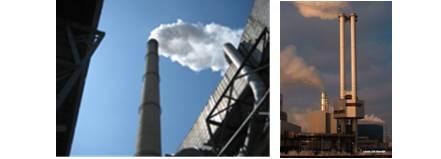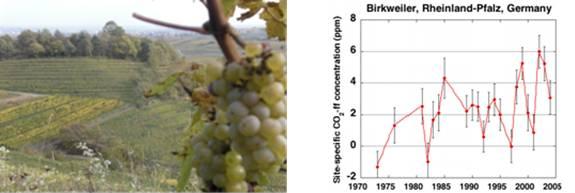Fossil - Biogenic carbon determination
Name: S.W.L. (Sanne) Palstra

Research aim
We develop methods based on 14C measurements to independently quantify and verify the biogenic and fossil carbon fractions of fuels, flue gas CO2 and atmospheric CO2. In the section Background more details can be found about the background of this field of research. In the section Radiocarbon measurements we explain why 14C measurements can be used to distinguish biogenic from fossil carbon fractions.
PhD Research topics
1. Development and validation of a 14C based method to determine the biogenic carbon fraction in different fuels and flue gas CO2 emissions.
- Determination of the biogenic fraction of flue gas CO2
- Improvement of the 14C method for fuel mixtures containing natural gas and/or biogas
- Biogenic and fossil carbon fractionation within the SNG production process
2. Determination of trends in atmospheric regional fossil fuel CO2 emissions based on 14C measurements of wine-ethanol and other plant materials.
1. Development and validation of a 14C based method to determine the biogenic carbon fraction in different fuels and in industrial flue gas CO2 emissions

- Determination of the biogenic fraction of flue gas CO2
In 2008 we have investigated the application of the 14C method to determine the biogenic carbon fraction of flue gas CO2 (Palstra and Meijer, 2010). We sampled, in cooperation with ECN (Energy Research Centre, Petten, the Netherlands), flue gas CO2 at a coal-biomass fired power plant with known biogenic and fossil carbon input and at a waste incineration plant with unknown carbon input.
The results of this study showed that the 14C method is a reliable method to determine the biogenic CO2 fraction of flue gas emissions at a power plant or waste incineration plant. The applied method allows us to determine biogenic CO2 fractions down to <5%. The 14C-based results of the power plant samples compared very well with the results based on in- and output carbon data of the power plant. During the sampling campaign (of two days) the biomass input was decreased with 50% and this decrease was directly visible in the obtained 14C-based results. At the waste incineration plant we determined an average biogenic CO2 fraction of 49 ± 4% during the sampling campaign (2 days).
- Improvement of the 14C method for fuel mixtures containing natural gas and/or biogas

The 14C method has not been tested yet specifically for biogenic and fossil fuel mixtures containing biogas and/or natural gas. We want to obtain insight in different aspects of biogas and natural gas that might influence the calculation of the biogenic carbon fraction of fuel mixtures or flue gas CO2 emissions. The aspects we currently investigate (Palstra and Meijer, to be submitted in 2012) are: 1) the influence of the isotope fractionation correction (not further explained here) in the 14C measurement on the determined biogenic carbon fraction of a sample containing carbon from natural gas and/or biogenic gas and 2) the 14C value of 100% biogenic gas. The latter 14C value is used as a reference value to determine the biogenic carbon fraction and this value can vary considerably between different fuel types. This study is part of the EDGaR AGATE-1 project.
- Biogenic and fossil carbon fractionation within the SNG production process
For the production of Synthetic Natural Gas (SNG) both biogenic and fossil input materials can be used (e.g. wood pallets or waste materials). During the production process part of the carbon is released (e.g. as CO2) and this carbon will therefore not be part of the produced SNG. The total input carbon will be divided into different carbon amounts: fractionation of carbon. This fractionation of carbon during the SNG production process might result in changes of the biogenic/fossil carbon ratio of the produced SNG compared to the ratio of the mixed input material. This can occur because in general the mixed fossil and biogenic input materials have different chemical and physical properties and can behave differently during the carbon fractionation. We want to investigate the carbon isotope composition of the different carbon fractions in the SNG production process, if a fossil/biogenic mixture of input material is used. We want to know whether the SNG product is becoming more or less ‘bio’ (or ‘green’) during the production process and therefore we want to investigate the changes in biogenic and fossil carbon ratio using the 14C method. We currently investigate the carbon isotope changes in a SNG production process in cooperation with ECN department Biomass, Coal and Environmental Research (ECN-BCE). This study is also part of the EDGaR AGATE-1 project.
2. Determination of trends in atmospheric regional fossil fuel CO2 emissions based on 14C measurements of wine-ethanol and other plant materials.

In the period 2007-2009 we have investigated the use of wine ethanol 14C measurements, to determine trends in atmospheric regional fossil fuel CO2 emissions. We will continue this research later this year (2012). In Palstra et al. (2008) we have showed that 14C measurements of (grape) wine-ethanol can be used to supplement atmospheric air 14C measurements. The use of wines to trace trends atmospheric fossil fuel CO2 has two big advantages: 1) we can measure annually and back in time as wines are stored for long periods and 2) we can indirectly measure atmospheric air during a few months at many different sites. In the study of 2008 we showed the trend in regional fossil CO2 concentrations in the atmospheric air at one wine-site for the period 1970-2005. In the period 2009-2010 we have measured other wine series from two other wine sites. We have also compared our wine based data with modelled regional fossil fuel CO2 concentrations (comparison with REMO and TM3).
Based on the results so far, we cannot determine trends in regional fossil fuel CO2 emissions yet. Part of the annual variation and perhaps also the trend in the determined regional fossil fuel CO2 concentrations are due to annual variation in atmospheric transport and mixing. We want to use modelled trends in atmospheric mixing and transport on the fossil fuel CO2 concentrations to correct for these kinds of annual variations.
For the wines we will further investigate these kinds of factors, other than fossil fuel CO2 emissions, that influence the measured 14C value. To use modelled data for instance, we should know the exact time period in which the investigated grapes (sugars transformed into wine-ethanol) have taken up carbon from the atmosphere. We currently cooperate in a PhD project of the Wageningen University to investigate the influences of differences in carbon uptake rate and sampling time and period on the measured 14C values in plants (maize and wheet) (Bozhinova et al., submitted in 2012).
References
Bozhinova, D., M. Combe, H.A.J. Meijer, S.W.L. Palstra, M.C. Krol, W. Peters (submitted in 2012), The importance of crop growth modeling to interpret the 14CO2 signature of annual plants, submitted to Global Biogeochemical Cycles.
Palstra, S.W.L., U. Karstens, H.-J. Streurman, and H.A.J. Meijer (2008), Wine ethanol 14C as a tracer for fossil fuel CO2 emissions in Europe: Measurements and model comparison, J. Geophys. Res., 113, D21305, doi:10.1029/2008JD010282
Palstra, S.W.L., and H.A.J. Meijer (2010), Carbon-14 based determination of the biogenic fraction of industrial CO2 emissions – Application and validation, Bioresource Technology, 101, 3702-3710, doi:10.1016/j.biortech.2009.12.004
Palstra, S.W.L. and H.A.J. Meijer (to be submitted in 2012), Biogenic carbon fraction determination of fuel mixtures containing biogas and/or natural gas – specific calculation issues within the 14C method (preliminary title), to be submitted to Radiocarbon.
Acknowledgements
Energy company Essent (RWE/Essent) has financed the 2008-project in which we have investigated the application of the 14C method at a power plant and a waste incineration plant.
For the research program EDGaR we acknowledge the contribution of the funding agencies: The Northern Netherlands Provinces (SNN), the European Union, European Fund for Regional Development and the Ministry of Economic Affairs and the Province of Groningen.
Links
14 C in wine ethanol in the press:
(websites in English)
http://www.rug.nl/corporate/nieuws/archief/archief2008/persberichten/154_08?lang=en
http://www.sciencemuseum.org.uk/antenna/wineCO2/
http://www.abc.net.au/science/articles/2008/12/01/2434027.htm
(websites in Dutch)
http://www.rug.nl/corporate/nieuws/archief/archief2008/persberichten/154_08
http://www.kennislink.nl/publicaties/fossiel-koolstof-in-wijn-brengt-europese-co2-emissie-in-kaart
| Last modified: | 18 January 2022 3.17 p.m. |
